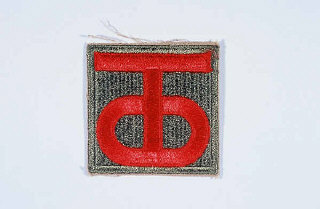BonnieBlueFlag tells us about the Tough Ombres
By BonnieBlueFlag

United States Holocaust Memorial Museum - Collections
The "Tough Ombres"
Speaking of Europe, and thinking about D-Day of 61 years ago today, I have been saying a special prayer of thanks, that my father was at Normandy that day, and lived to come home to his family and loved ones.
Omaha beach was the bloodiest landing, and rightfully the most well known. There were four other landing areas as well; Utah beach was the other American landing, with the British areas known as Gold and Sword beaches. The Canadians landed on Juno beach which was flanked by Gold and Sword.
The 90th Infantry Division, which included my father, came ashore on Utah beach 2.5 kilometers (about 1&3/5th miles) more south than planned. This navigational miscalculation put the Americans out of range of the powerful coastal batteries, thus saving the lives of many of our soldiers on this first day.
The Insignia of the 90th Infantry Division (shown above) was made up of the letters "T" for Texas and "O" for Oklahoma to represent those states during the first World War. At the time of the second World War, the "T&O" included soldiers from many other states.
They became known as the "Tough Ombres," or the Alamo Division during the second World War.
A few hours after landing, the Americans had cleared the beach of the Germans and their armaments, and moved inland.
The Tough Ombres would fight their way through the French Hedgerows, and go on to make the 100 mile march with General Patton, in order to participate in the Battle of the Bulge (December 16, 1944, to January 25, 1945.)
On April 23, 1945, the 90th liberated the Flossenburg concentration camp and about 1,600 weak and sickly prisoners. Just three days earlier, the SS had taken about 22,000 other prisoners from the camp on a forced march to Dachau, Germany. Approximately 7,000 prisoners died from illness or were shot before reaching Dachau.
There are numerous plaques and memorials in small villages all over France in memory of the "Tough Ombres." The one shown below was erected near the area that was designated as Utah beach on D-Day.

By: BonnieBlueFlag


1 Comments:
Bonnie, how fortunate you are, that your hero father survived this D-Day hell and came home again! I remember seeing on TV, at the time of the 60th anniversary of D-Day, the same black and white footage over and over again, of the landing crafts disgorging their brave men into the shallow water, in the distance the few abandoned houses high on the bluff, and the same poor soldier at the instant that he was shot and collapsed forwards into the water, only seconds after leaving the safety of the craft. Even thinking of it now makes me tear up. I can't even begin to imagine what a hell that must have been...and the war still had a year to run! Thanks for this interesting note on the navigational miscalculation that no doubt saved your father from being that poor hapless man.
Post a Comment
<< Home